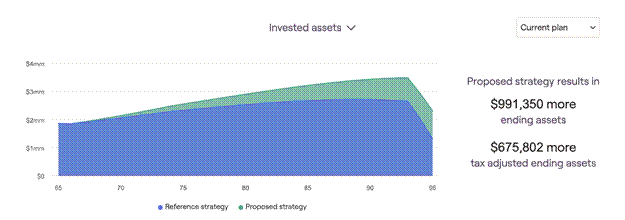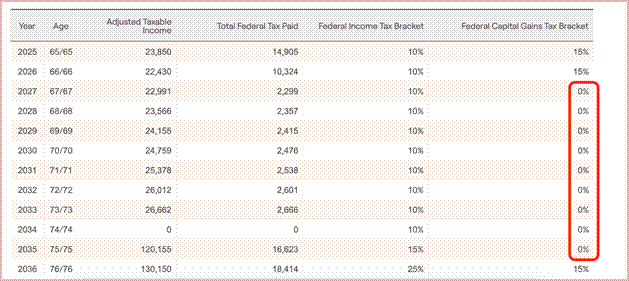Tax-Smart Retirement Withdrawals: The Fine Art Of Not Giving Uncle Sam Your Lunch Money
It's not just about having money – it's about keeping more of it. The post Tax-Smart Retirement Withdrawals: The Fine Art Of Not Giving Uncle Sam Your Lunch Money appeared first on Above the Law.

Every morning at about 6:47 AM, my 4-year-old daughter’s head pops off the pillow with the same urgent question: “What are we doing today?”
I’ll be brutally honest – most mornings I’m just hoping for 30 minutes of uninterrupted coffee time. But she needs that roadmap. She needs to know what’s next.
As adults, we often forget we’re wired the same way. You wouldn’t buy a house without seeing the contractor’s blueprint first. You’ll never see the finished house until it’s built, but that detailed plan gives you confidence it’ll look right.
The same principle applies to retirement – especially for lawyers.
When I talk with lawyers approaching retirement, the anxiety isn’t usually about the numbers. You’ve built successful careers, accumulated assets, done the “right” things financially. The struggle runs deeper than that.
It’s a loss of identity. Who are you without the courtroom, the clients, the late-night brief writing?
But there’s another piece that compounds this emotional uncertainty: no one has ever shown you a clear financial blueprint for how retirement actually works. And it’s really hard to feed your emotional confidence when there isn’t even a clear picture of how it all works from a financial perspective.
That’s where a strategic plan with tax-smart withdrawal strategies comes in. Think of this as your retirement blueprint – a detailed plan that marries the emotional side with the financial side to provide confidence about what the next phase should look like.
Why Withdrawal Sequencing Matters More Than You Think
You’ve got three main buckets of retirement assets, and each gets taxed differently:
Taxable accounts (your regular investment accounts) – You pay taxes on dividends and capital gains, but you’ve already paid income tax on the money that went in.
Tax-deferred accounts (Traditional 401k, Traditional IRA) – Every dollar you withdraw gets taxed as ordinary income. Yikes.
Tax-free accounts (Roth IRA, Roth 401k) – No taxes on withdrawals in retirement. None.
Why does this matter? Because the order you tap these accounts can make the difference between keeping more of your money versus handing it over to Uncle Sam. We’re talking about spendable income, gifting capacity, and funds for your beneficiaries.
The conventional wisdom says just take a little from each account pro-rata style (might as well spread it around, right?).
But here’s where it gets interesting – that’s not always the smartest approach.
Let me introduce you to Rachel and Caleb Justice (not their real names of course). Both lawyers, both 65, both ready to retire with a $2.6 million net worth. They need about $10,000 monthly in after-tax expenses plus healthcare costs – roughly $120,000+ annually. Here’s what their retirement asset picture looks like:

Looking at their three buckets:
- Tax-deferred accounts: $1.15 million (Caleb’s 401k + Rachel’s Rollover IRA)
- Tax-free accounts: $425,000 (both Roth IRAs)
- Taxable accounts: $300,000 (Joint Brokerage)
Rachel and Caleb had a critical decision to make about Social Security timing and withdrawal sequencing. In their case, they were solving for lifetime income while paying the least amount in projected taxes.
They employed an intentional withdrawal strategy: taxable accounts first, then tax-free, then tax-deferred. And instead of taking Social Security immediately, they delayed until full retirement age (67 in their case).
The result? This strategy added over $675,000 in tax-adjusted ending assets to their plan compared to the conventional pro-rata approach.

But they didn’t stop there.
The Power of Strategic Roth Conversions
First, let me explain what a Roth conversion actually is. It’s pretty simple: you take money from your tax-deferred accounts (like a 401k or traditional IRA) and move it to a Roth IRA. You pay taxes on that money today, but then it grows tax-free forever. No taxes when you withdraw it. No Required Minimum Distributions forcing you to take money out. It’s like paying the tax bill upfront to never get another tax bill on that money again.
With that introduction to Roth conversions out of the way, let’s get back to Caleb and Rachel:
Between ages 65 and 73 (when Required Minimum Distributions kick in), they made a strategic move: they converted money from their tax-deferred accounts (401k and Rollover IRA) to Roth IRAs – enough to fill up their 10% tax bracket each year.
They didn’t spend this money. Instead, they elected to pay taxes today at a lower rate than they were projected to be once those pesky RMDs kicked in. Think of it as “topping off” their lowest tax bracket and moving money from the “pay taxes later” bucket to the “never pay taxes again” bucket.
This additional wrinkle? Now we’re looking at over $800,000 in more tax-adjusted ending assets.

Let’s bring this concept home — proper coordination between Social Security timing, pension sources, and your distribution strategy can dramatically impact your lifetime income. It’s not just about having money – it’s about keeping more of it.
Capital Gains Harvesting: The “0%” Sweet Spot
Here’s something that might surprise you: there’s actually a 0% capital gains tax bracket in retirement.
Here’s how it works — When you sell investments in your taxable accounts, you pay capital gains tax on the profit. If you hold those investments for more than one year, you get preferential tax treatment called “long-term capital gains” – which is taxed at much lower rates than ordinary income. But – and this is the beautiful part – if your taxable income stays below certain thresholds, you pay exactly zero percent on long-term capital gains.
For 2025, married couples filing jointly can have up to $94,050 in taxable income and still qualify for the 0% capital gains rate. Single filers get up to $47,025. Again, this is taxable income, which means with a standard deduction a couple filing jointly could have up to $127,250 in total income and still qualify ($94,050 plus standard deduction of $33,200).
Where does this fit in? Well, let’s head back to our example with Caleb and Rachel:
Between ages 67 and 75, their strategic withdrawal sequencing kept their taxable income in that sweet spot. The result? They paid 0% in capital gains taxes during those crucial early retirement years.

This isn’t about fancy financial engineering. It’s about understanding how the tax code works and positioning yourself to take advantage of it.
Your Retirement Blueprint Starts Here
Remember my daughter’s morning question? “What are we doing today?”
The lawyers I work with need that same clarity about retirement. Not just the warm, fuzzy vision of “more time with family” – though that’s important too. You need a concrete financial blueprint that shows exactly how the money flows, when taxes hit, and how to keep more of what you’ve worked so hard to build.
Tax-smart withdrawal strategies aren’t just about minimizing taxes (though they do that beautifully). They’re about creating a clear, executable plan that gives you confidence in your next chapter.
And I’ve learned that when you have that financial blueprint in place, the emotional piece starts falling into place too. You begin to see retirement not as an ending, but as a strategic transition to a new phase of life.
Your retirement deserves more than a “wing it and hope” withdrawal strategy – and so do you.
DISCLOSURE: The information in this article is not intended as tax, accounting, retirement or legal advice, as an offer or solicitation of an offer to buy or sell, or as an endorsement of any company, security, fund, or other securities or non-securities offering. This information should not be relied upon as the sole factor in an investment making decision or your decision to retire. In any examples or case studies used, all client names have been changed.

David Hunter, CFP® is a CERTIFIED FINANCIAL PLANNER™ and owner of First Light Wealth, LLC, a financial planning & wealth management firm with a unique focus on serving attorneys nationwide. David has over a decade of experience helping clients build financial plans and has been featured in publications such as Attorney at Work, ThinkAdvisor, MarketWatch, Financial Planning, and InvestmentNews. David also writes weekly to attorneys in his popular Money Meets Law newsletter. For more about David, visit firstlightwealth.com/lawyers or connect with him on LinkedIn.
The post Tax-Smart Retirement Withdrawals: The Fine Art Of Not Giving Uncle Sam Your Lunch Money appeared first on Above the Law.


















































































































































